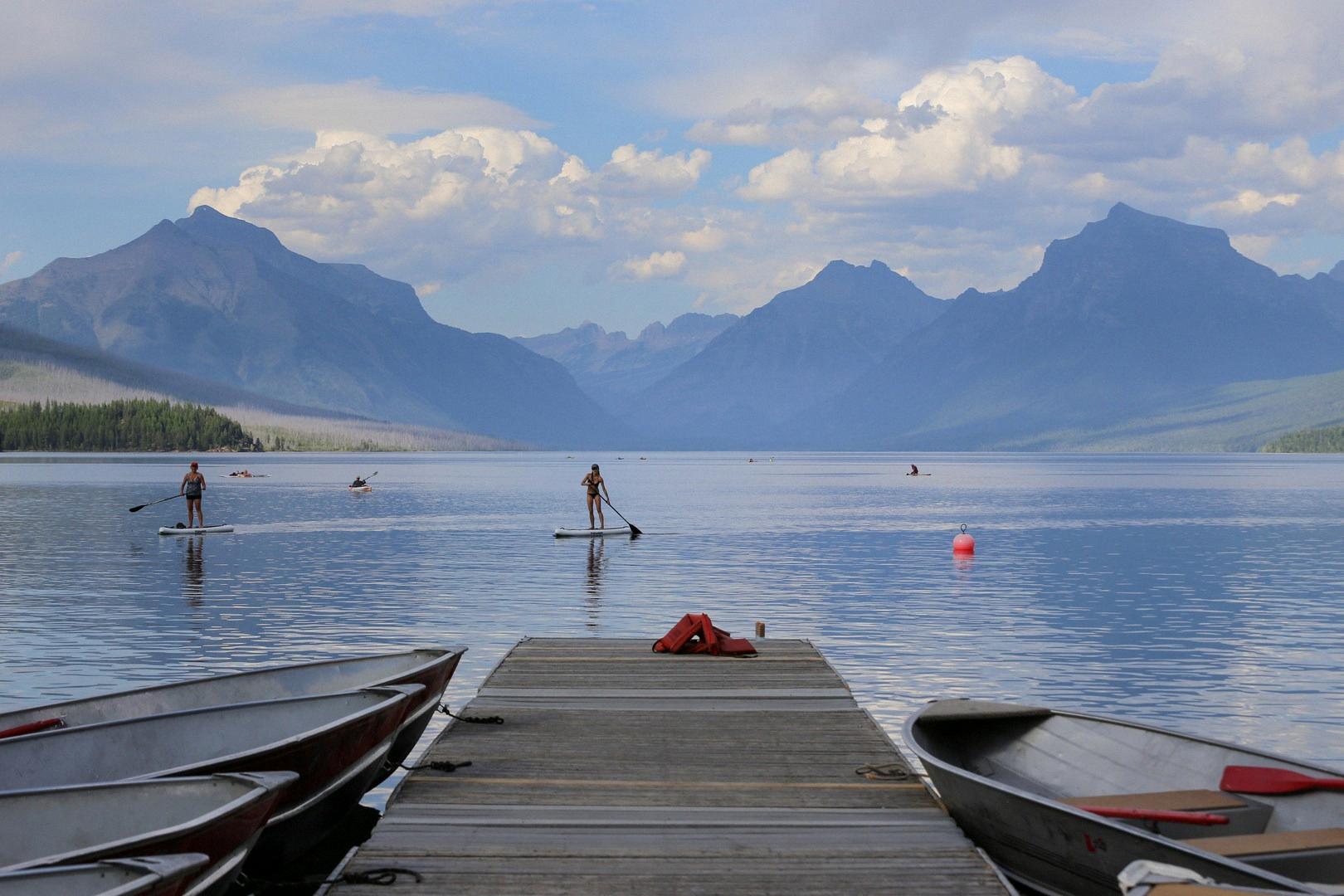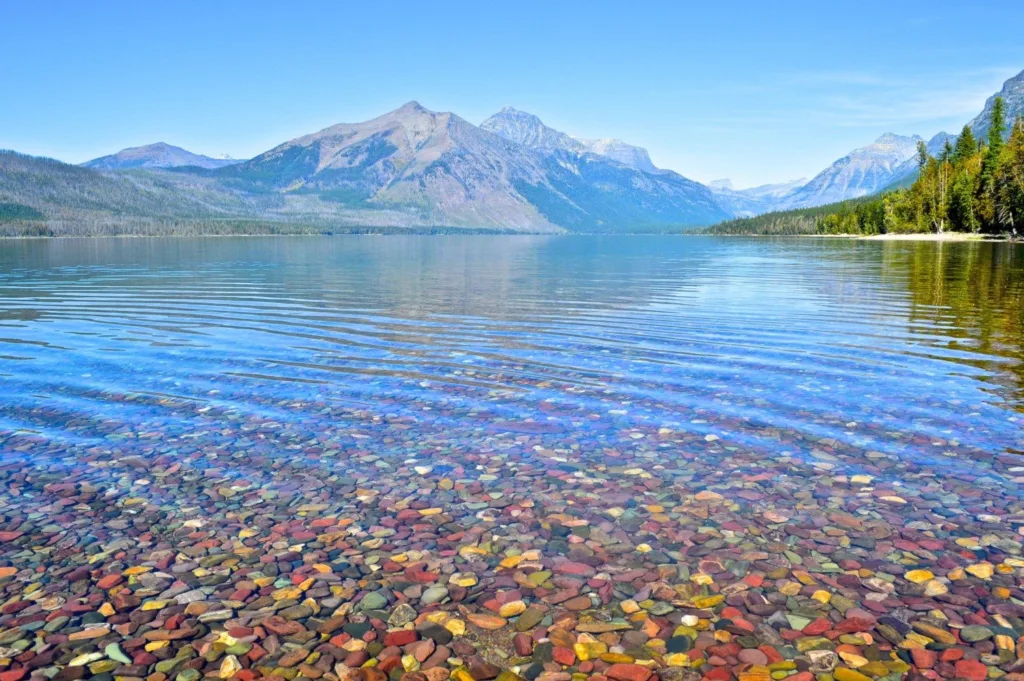Lake McDonald is a natural wonder that boasts a unique feature – the colored pebbles that line its shores and bed. These rocks are a sight to behold, with their rich and vibrant colors that add to the beauty of the lake. But what causes these rocks to be so colorful? Let’s dive deeper into the geology of Lake McDonald.
The rocks that make up the bed and shores of Lake McDonald are primarily Argillite, a sedimentary rock that was deposited as clay in shallow seas over 800 million years ago. This sedimentary rock is kown for its unique coloring, which comes from the small amount of iron present in its composition.
The colors of the rocks can tell us a lot about their formation. Red rocks indicate that oxygen was present when the rock was formed, while green rocks indicate that the atmosphere was lacking in oxygen. The green rocks found in Lake McDonald were formed in deep water and have less iron, resulting in their distinct color.
These colorful rocks can be found all around Glacier National Park and were formed at different eras. When the glaciers came, they broke down the rocks into tiny fragments, which were then washed away by rivers and deposited onto the lakes and tarns.
The unique coloring of the rocks adds to the beauty of Lake McDonald. Visitors to the area can spend hours exploring the shoreline and admiring the different colors and patterns of the rocks. Rock hounds from all over the world are drawn to the area to study and collect these unique specimens.
Lake McDonald is a natural wonder that boasts a unique feature – the colored pebbles that line its shores and bed. These rocks are primarily Argillite, a sedimentary rock that was deposited as clay in shallow seas over 800 million years ago. The striking colors of the rocks come from the small amount of iron in their composition. The green rocks were formed in deep water and have less iron, resulting in their distinct color. Visitors to the area can spend hours exploring the shoreline and admiring the different colors and patterns of the rocks.
Why Are There Colorful Rocks In Lake McDonald?
The colorful rocks in Lake McDonald are a result of the amount of iron present in them. These rocks were formed in the distant past and over time, they were broken down into small pieces that eventually found their way into the lake. The green rocks found in the lake were formed in deep water and contain relatively less iron than the other colored rocks. The presence of iron in the rocks imparts a wide range of colors including red, orange, yellow, and brown. This phenomenon is not unique to Lake McDonald as it is a common occurrence in many other bodies of water arund the world.

Where Are The Rocks On Lake McDonald?
The rocks that are found on Lake McDonald are actually present all around Glacier National Park. These rocks were formed during different eras. However, when the glaciers arrived, they broke down these rocks into tiny fragments, which were then carried away by the rivers. Many of these fragments got deposited onto the lakes and tarns, which are lakes formed by filling the bottoms of ice-scoured amphitheaters. Therefore, it can be concluded that the rocks on Lake McDonald are a result of the glacial activity that occurred in the area, and they can be found all around Glacier National Park.
Why Are The Rocks Colored At Glacier?
The rocks at Glacier are primarily made of Argillite, whih is a type of sedimentary rock that was formed over 800 million years ago by the deposition of clay in shallow seas. The distinctive red and green colors of the rocks are due to the presence or absence of oxygen during their formation. The red color indicates that oxygen was present, while the green color indicates that there was a lack of oxygen. The rocks contain a small amount of iron which gives them their striking color. the color of the rocks at Glacier is due to the composition of Argillite and the presence or absence of oxygen during their formation.
Does Lake McDonald Have Crystals?
Lake McDonald has crystals. The lake is known for its crystal clear waters that are perfect for swimming, kayaking, and paddleboarding. The crystals in the lake are formed from the minerals that make up the surrounding rocks and are often found in the form of quartz or calcite crystals. These crystals can be found along the shoreline and in the sand at the bottom of the lake. Additionally, there are many crystal formations in the surrounding mountains that can be seen from the lake itself.

Conclusion
The rocks of Lake McDonald are a fascinating natural wonder that adds to the beauty of Glacier National Park. The variation in colors, ranging from red to green, is due to the amount of iron and oxygen present during ther formation over 800 million years ago. These rocks were broken down by glaciers and deposited onto the lakes and tarns, creating a stunning display of colors that attracts rock hounds and nature enthusiasts alike. The Argillite sedimentary rock that makes up these rocks is not only visually striking but also a testament to the geological history of the area. Lake McDonald and its colorful rocks are truly a must-see destination for anyone interested in the natural wonders of the world.
